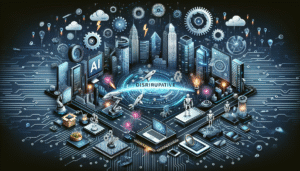
Cybersecurity Threats in a Connected World: Navigating the Digital Minefield
The Expanding Attack Surface: The proliferation of internet-connected devices, from smartphones and laptops to smart appliances and industrial control systems, has dramatically expanded the attack surface for cybercriminals. This interconnectedness, while offering unparalleled convenience and efficiency, creates a complex web of vulnerabilities that can be exploited. Every connected device represents a potential entry point into a network, increasing the risk of data breaches, malware infections, and other cyberattacks. This interconnected ecosystem necessitates a comprehensive and evolving cybersecurity strategy.
Phishing and Social Engineering: Human error remains one of the weakest links in the cybersecurity chain. Phishing attacks, employing deceptive emails, messages, or websites to trick individuals into revealing sensitive information, continue to be a prevalent threat. Sophisticated social engineering tactics prey on human psychology, manipulating individuals into clicking malicious links, downloading infected attachments, or divulging login credentials. The increasing use of social media platforms further amplifies the reach and impact of these attacks. Effective cybersecurity training and awareness programs are crucial to mitigating this risk.
Ransomware: A Growing Menace: Ransomware attacks, where malicious software encrypts data and demands payment for its release, have become increasingly common and damaging. These attacks can cripple businesses, government agencies, and critical infrastructure, causing significant financial losses and operational disruption. The rise of Ransomware-as-a-Service (RaaS) has lowered the barrier to entry for cybercriminals, making these attacks more accessible and widespread. Robust data backup and recovery strategies are essential for minimizing the impact of ransomware attacks.
Malware Evolution: Advanced Persistent Threats: Malware continues to evolve in sophistication and complexity. Advanced Persistent Threats (APTs) represent a particularly dangerous form of malware, designed to infiltrate networks undetected and remain dormant for extended periods, gathering sensitive data and intellectual property. These targeted attacks often employ multiple stages and advanced evasion techniques, making them difficult to detect and remediate. Proactive threat hunting and advanced security analytics are critical for combating APTs.
The Internet of Things (IoT) Vulnerability: The rapid adoption of IoT devices has introduced a new dimension of cybersecurity challenges. Many IoT devices lack adequate security features, making them easy targets for hackers. Compromised IoT devices can be used to launch distributed denial-of-service (DDoS) attacks, infiltrate home networks, or even gain control of critical infrastructure. Securing the IoT ecosystem requires a multi-layered approach, including strong device authentication, secure software updates, and network segmentation.
Data Breaches and Privacy Concerns: Data breaches, where sensitive information is stolen or compromised, pose a significant threat to individuals and organizations. The increasing amount of personal data stored and processed online makes data breaches a lucrative target for cybercriminals. The consequences of data breaches can be severe, including financial losses, reputational damage, and legal liabilities. Implementing robust data security measures, including encryption, access controls, and data loss prevention (DLP) solutions, is crucial for protecting sensitive data.
Cloud Security Challenges: The widespread adoption of cloud computing presents both opportunities and challenges for cybersecurity. While cloud services offer scalability and cost-effectiveness, they also introduce new security risks. Data breaches, unauthorized access, and misconfigurations can expose sensitive data stored in the cloud. Organizations must implement robust cloud security strategies, including strong access controls, data encryption, and regular security assessments.
The Rise of Artificial Intelligence in Cybersecurity: Artificial intelligence (AI) is playing an increasingly important role in both offensive and defensive cybersecurity strategies. AI-powered tools can be used to automate security tasks, detect anomalies, and predict potential threats. However, cybercriminals are also leveraging AI to develop more sophisticated attacks. The future of cybersecurity will likely involve an ongoing arms race between AI-powered defenses and AI-powered attacks.
Cybersecurity Regulations and Compliance: The increasing number of cybersecurity regulations and compliance requirements adds another layer of complexity for organizations. Regulations such as GDPR, HIPAA, and PCI DSS mandate specific security controls and data protection measures. Organizations must ensure compliance with these regulations to avoid penalties and maintain customer trust.
Building a Strong Cybersecurity Posture: Navigating the complex landscape of cybersecurity threats requires a proactive and comprehensive approach. Organizations must implement a multi-layered security strategy, encompassing strong passwords, multi-factor authentication, regular software updates, robust firewall protection, intrusion detection and prevention systems, and employee security awareness training. Regular security assessments, vulnerability scanning, and penetration testing are essential for identifying and mitigating potential weaknesses. Collaboration and information sharing within the cybersecurity community are also crucial for staying ahead of evolving threats.















